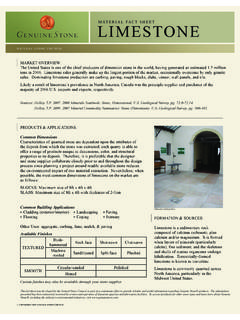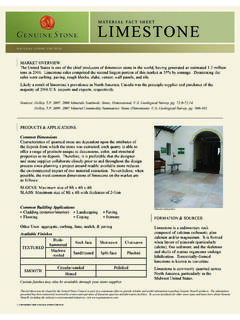Transcription of Sandstone Quarrying and Processing: A Life-Cycle …
1 Sandstone Quarrying and Processing: A Life-Cycle Inventory A Report Prepared for: The Natural Stone Council Prepared by: University of Tennessee Center for Clean Products August 2008. Copyright 2008 Natural Stone Council Table of Contents 1 INTRODUCTION 1. 2 Sandstone Quarrying AND PROCESSING OPERATIONS 2. Sandstone 2. Sandstone Quarrying OPERATIONS 2. Sandstone PROCESSING OPERATIONS 3. 3 LCI METHODOLOGY 5. LCI DATA COLLECTION 5. QUALITY OF LCI DATA SET 5. LCI BOUNDARIES 5. Sandstone QUARRY OPERATIONS 5. Sandstone PROCESSING OPERATIONS 6. 4 LCI RESULTS 7. REFERENCES 24. ii List of Figures FIGURE 1. PROCESS FLOW DIAGRAM FOR Quarrying 2. FIGURE 2. PROCESS FLOW DIAGRAM FOR PROCESSING 3.
2 List of Tables TABLE 1. GROSS ENERGY TO PRODUCE ONE TON OF Sandstone PRODUCTS.. 7. TABLE 2. WATER CONSUMPTION FOR Sandstone Quarrying AND PROCESSING.. 7. TABLE 3. LCI INPUTS FOR Sandstone Quarrying AND PROCESSING.. 8. TABLE 4. LCI OUTPUTS FOR Sandstone Quarrying AND PROCESSING.. 14. TABLE 5. OTHER ANCILLARY INPUTS FOR Sandstone Quarrying AND PROCESSING.. 23. TABLE 6. OTHER ANCILLARY OUTPUTS FOR Sandstone Quarrying AND 23. iii 1 Introduction The Natural Stone Council (NSC) is a collaboration of businesses and trade associations that have come together to promote the use of Genuine Stone in commercial and residential applications. By pooling resources, their goal is to increase the understanding of, preference for, and consumption of these natural products.
3 Trade associations affiliated with the NSC include Allied Stone Industries, Building Stone Institute, Elberton Granite Association, Indiana Limestone Institute, Marble Institute of America, National Building Granite Quarries Association, and the National Slate Association. Recognizing that green building was becoming a permanent element of the marketplace, the NSC established a Sustainability Committee made up of key industry members to elevate the issue of sustainability within the industry and provide a body responsible for planning and implementing relevant initiatives. In 2007, the NSC Sustainability Committee engaged in a partnership with the Center for Clean Products (CCP) at the University of Tennessee to assess current industry operations relating to dimensional stone production.
4 Prior to this evaluation, the environmental implications of stone extraction and fabrication processes had received little attention compared to other industries. In particular, Life-Cycle inventory (LCI) data on natural stone products was limited, not well documented, and out-of-date. This information gap was partially due to the size and varying scale of industry members, the vast diversity of products and materials produced, and the global distribution of stone Quarrying activities. As such, this work presents the most comprehensive survey to-date of the natural stone industry's practices. Provided in the following text are the results of the first phase of a three-year project launched by the NSC to benchmark and improve the environmental profile of the natural stone industry.
5 Specifically, the information that follows is an initial LCI characterizing Sandstone extraction and production operations in North America. These data will serve as a baseline from which industry best practices can be identified, comparisons to competing products can be made with regard to environmental considerations, and future research can be prioritized. 1. 2 Sandstone Quarrying and Processing Operations Sandstone Sandstone is a sedimentary rock comprised of lithified sands. Most is primarily quartz sand or a mix of quartz and feldspar sands in conjunction with interstitial cementing materials including calcite, clay, iron oxides, and silica. The lithification process results in a hard, dense material that takes on the color of its components, most commonly tan to yellowish or tinted pink to dark red due to varying levels of iron oxide.
6 The commercial Sandstone category encompasses many variations of texture and color. Common forms of Sandstone include arkose which has a high feldspar content, graywacke which contains angular rock fragments, and conglomerate which contains rounded rock fragments. Other common stones included in this category are bluestone, a hard, dense feldspathic Sandstone , brownstone, a reddish-brown stone taking its color from its high iron content, and flagstone, a Sandstone or sandy slate that is easily split into large, thin slabs. Sandstone accounts for 15% of the stone produced in the United States, putting it in third place behind limestone and granite. It is quarried in 16 states with Arizona, New York, Ohio, Colorado, and Arkansas leading the industry.
7 Sandstone 's primary uses include dressed stone for flagging, ashlars, and partially squared pieces as well as rough blocks for building and construction (Dolley 2007). Two general phases of Sandstone production exist: Quarrying and processing. Each of these phases is described below. Sandstone Quarrying Operations Extraction (more commonly referred to as Quarrying ) consists of removing layers or large pieces of stone from an identified and unearthed geologic deposit. Differences in the particular Quarrying techniques used often stems from variations in the physical properties of the deposit itself such as density, fracturing/bedding planes, and depth financial considerations, and the site owner's preference.
8 Nevertheless, the process is relatively simple: locate or create (minimal) breaks in the stone, remove the stone using heavy machinery, secure the stone on a vehicle for transport, and move the material to storage. A flow diagram of typical Quarrying operations is shown in Figure 1. Overburden (and Transportation to Extraction Plug) Removal Storage Scrap Stone Transportation to Scrap Stone & Storage at On- Quarry Backfilling site Location Transportation to &. Crushing at Crushing Facility Figure 1. Process flow diagram for Quarrying operations. 2. As shown in Figure 1, the first step in Quarrying is to gain access to the Sandstone deposit. This is achieved by removing the layer of earth, vegetation, and rock unsuitable for product collectively referred to as overburden with heavy equipment and transferring to onsite storage for potential use in later reclamation of the site.
9 Additionally, a plug of poor-quality stone may sit atop the material that has commercial value; this plug must also be removed with the overburden. After the face of the deposit is exposed, the stone is removed from the quarry in layers or pieces. If bedding planes are visible, forklifts and/or steel wedges are driven between the strata to pry up the layers. Alternatively, loose pieces are scooped up with front-end loaders, dump trucks, or other equipment. Once the layers or pieces are secured on the heavy machinery, they are transferred to an inspection area for grading, temporary storage, and eventual shipment from the site. Sandstone of insufficient quality or size for current demand is stored on-site for future use, such as for site reclamation activities, or sent to a crushing facility to be used in other applications.
10 Sandstone Processing Operations Processing operations include much more variation than extraction. Nevertheless, the general procedures begin with initial cutting, followed by application of a finish, and conclude with a second cutting or shaping step. Due to the array of stone products, the second and/or third steps may be eliminated, specifically when the product will have a natural appearance. Figure 2. depicts the fabrication process. Figure 2. Process flow diagram for processing operations. The first step in Sandstone processing is a primary cutting or shaping of the material. This is often accomplished for Sandstone using a circular blade saw, but a splitter or hand tools, such as axes and mauls, can also be implemented.








